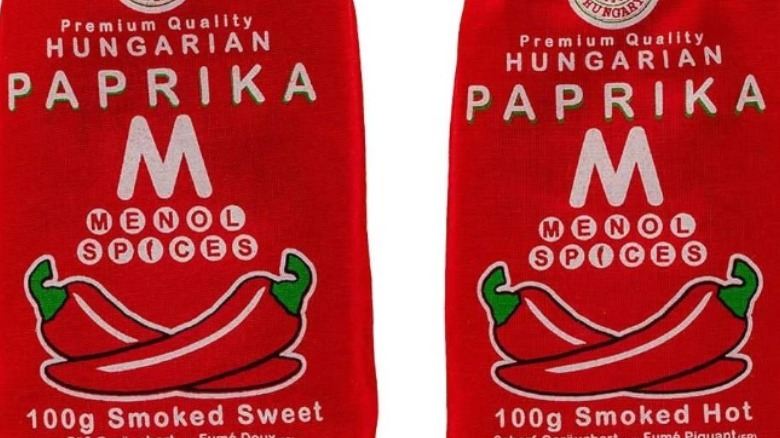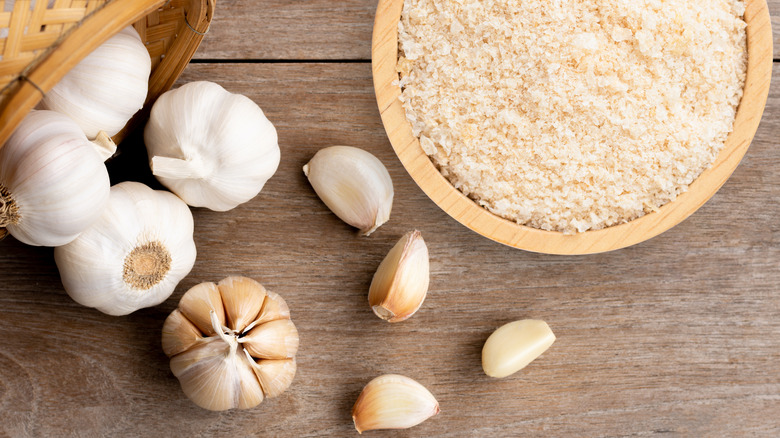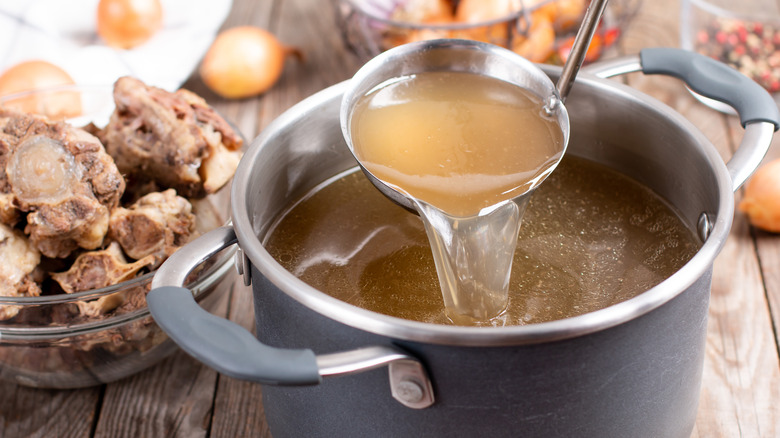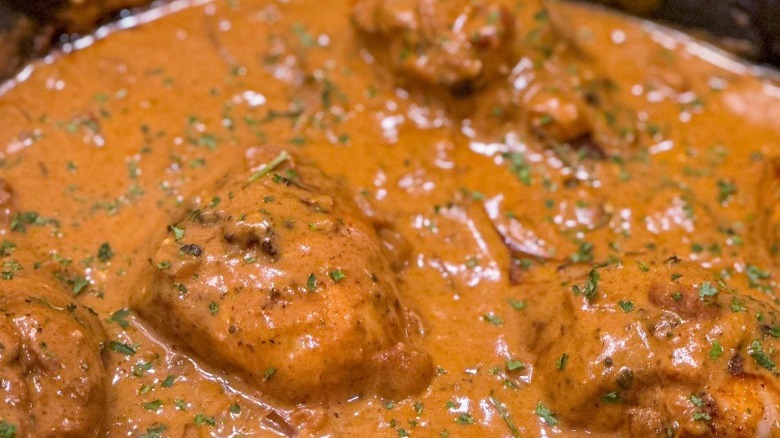8 Ways To Fix Paprika Overload
We may receive a commission on purchases made from links.
Paprika is one of the most well-known and commonly used spices. Paprika comes from Capsicum annum, a sweet and chili pepper that is dried out, ground, and bottled to be used as an ingredient in dishes like chicken, stew, sausages, and many more. Some of the most famous paprika dishes include goulash, chicken paprikash, and chorizo. Paprika is also used in other famous spices, such as the Arabic baharat seasoning.
With so many dishes looking to add the bitter, peppery spice to create more of a taste, it's important to know how to cook with it. The amount of the spice that you use depends on the taste of the dish you're trying to make. Too sweet, and you'll need to add more; too savory, and you'll need to ease up. Adding too little can always be corrected, but some people overuse paprika, seemingly, the point of no return for the dish. If you've struggled with overusing the robust spice and not knowing how to fix it, we've compiled eight crucial tips to remedying too much paprika.
Determine what paprika you're using
In order to correctly determine what level of paprika to add or what remedy to use when you've added too much, it's important to first figure out what paprika you're using. There are a handful of main types of paprika, all varying in sweetness and spiciness, and knowing which one you should use will help you navigate the best course of action.The three types include basic paprika, Hungarian paprika, and Spanish paprika. The basic paprika is what you'll often find at any chain grocery store. It's a mild version of the spice, acting as the least intense of the three spice iterations. It doesn't teeter either way on the line of sweetness and heat, falling right about in the middle. The biggest appeal of this paprika, and one pro over all the variations, is the deep red color.
The Hungarian paprika is one of the biggest spices in the country and is at the heart of the national dish, Hungarian goulash. Hungarian paprika is more multifaceted in its flavor, having a large range of sweet and spicy types of paprika. Typically, the sweet paprika is what Hungary is known for. Finally, Spanish paprika lands on the opposite end of the spice spectrum and has a more peppery, smoky flavor that brings the kick out more than sweeter styles. All three types of paprika bring different qualities to the table, but it's crucial to know which one you're working with to determine the remedy.
Reach into the spice cabinet
The first solution for remedying too much paprika in any dish is to reach back into the spice cabinet. Understanding what spices complement paprika is crucial to being able to remedy the dish. One spice that always does the trick is cumin, a dried spice presented in either its seed form or ground into a powder. This spice is used in dishes like yogurt-based raita recipe or the potato recipe aloo jeera, or a classic masala dosa, a rice and lentil crepe with potatoes inside. Cumin also pairs well with paprika because the sweet and spicy bitterness of the paprika is balanced with the earthy and citrusy taste.
Another example recommended by McCormick spices is to use garlic powder instead of the cloves. McCormick suggests that because garlic powder works so well in savory dishes, adding to the bitter taste of paprika to enrich the flavor and slightly calms the intensity of the paprika. All in all, both spices balance out the paprika, adding more flavor and creating a tasty solution to the overuse of paprika. This way, you're not altering your dish too much, and you're even enhancing its flavor.
Activate your sweet tooth
For the bitter taste of too much paprika, another good solution can come from adding some cooking sweeteners to your dish. Because most of the sweetness within paprika becomes overpowered by its bitter, smoky flavoring, adding a bit of sugar can help to balance out an overuse of the spice. This is even a viable solution with other spices that are savory and overused in a dish.
The two solutions for over-seasoned dishes are sugar or honey. Ground sugar can be a good match for paprika if you work it into the dish sparingly. It'll add a pop of sweetness and make up for the sharp spice. Honey is thicker but is used in many meat preparations and other dishes anyway, so it will likely fit right into whatever you're cooking. Other natural sweetener solutions are agave nectar, maple syrup, or even fruit jam. As for which of the sweeteners you should add, you just need to use your best judgment and rely on your personal preference.
Break out acidic ingredients
If adding more spices or balancing with sweetener does not work, another great solution comes from adding in acidity. Lemon juice, vinegar, and other acidic ingredients mask the paprika's bitter taste, while also complementing it. With sweet dishes and sweeter Hungarian paprika, the acidity brings a sour taste to offset some of the sugary taste.
With smoky dishes, the acidic flavor complements the kick, mostly taking away the bitterness from the raw spice of paprika. Acid products also save most dishes from being too flat, if when cooking the flavor feels too dull. Technically, using acid in a dish with too much paprika counts as a method of adding in an ingredient while also diluting the recipe, but it is a less extreme version of this. When it comes to saving yourself from overuse, it is always better to try adding something before potentially ruining the recipe by diluting too much.
Dilute the recipe
When adding complementary ingredients fails, adding diluting ingredients to an over-spiced dish is the best next step. For a neutral way to dilute a recipe, the obvious solution is water. The problem here is that if you add too much water, a dish will taste, for lack of a more accurate description, too watered-down. Another more neutral method of dilution is cooking stock or broth, be it chicken, beef, vegetable, or bone broth. The broth you use depends on the dish you are making, and your personal preference.
Diluting the dish gives more space to spread out the spices, while simultaneously taking away the overpowering flavor that is ruining the dish. Of course, using water and broth to dilute the dish is also up to your best judgment, as certain dishes would suffer from adding in a bunch of liquid, let alone any liquid at all. However, with the lack of flavor from water and the mellow broth flavor, dilution can perfectly balance out too much paprika.
Dairy is the best mask
If in the event water and broth are too flavorless for what you are imagining in your dish, then dairy products are another diluting technique. It's a known fact that milk is a cure for spicy food aftertaste. According to Houston Methodist, milk products have casein, a protein that breaks down the capsaicin that exists in spicy foods. That's why, when the taste of the paprika spice becomes overwhelming in any dish, dairy products are a good diluting agent.
However, Houston Methodist does specify that it has to be real dairy products, though. Substitutes like almond milk or soy milk won't suffice, because they don't have the casein. But, milk isn't the only dairy that can dilute. Yogurt, cottage cheese, sour cream, and other dairy products will do the trick well, as long as they have the casein protein. Plus, the thick and creamy nature of the dairy products will act as a flavor enhancer in addition to calming down the paprika's kick.
Ease up on the heat by adding in meat
If adding in spices or other flavors, or working to dilute a recipe that doesn't work, you can try altering the recipe to add more of the base of what you're cooking. Paprika is often used in meat dishes, hence some popular dishes being goulash, a chicken and rice with paprika, and chorizo. The paprika's flavor, be it any of the three kinds, brings out a smoky, intense flavor for the meat.
However, if you have overused paprika and are out of options, adding more meat can be a good way to disperse the spices. The meat you use in the base, if you have extra laying around, soaks up the spice and makes it feel more evenly distributed throughout the dish. Then, not only have you fixed your paprika problem, but you have now made enough food to have some great leftovers for the week and to share with your loved ones.
Absorb the spice with potatoes
If you're cooking a dish without meat, or you're a vegetarian looking for a different option, you can add potatoes to dilute the spice. Some people don't believe in the potato method, saying that it's not as good of a diluting or absorbing agent. However, for those who don't believe in it, other starches like crackers, bread, and rice will do the trick at making the paprika's spice calm down and diffuse throughout the dish.
If starches are not your preferred base, or you are looking for something different, vegetables make for a good base that can easily absorb the paprika spice. On the upside for this option as well, vegetables often taste much better with ample seasoning to complement and enhance their flavor. Either way, starch and vegetables both work hard to absorb the flavor and can easily remedy the overuse of paprika within your dish. So, don't fret. Whether you add in spices, dilute the recipe, or absorb the spice, there are always solutions if you've overused paprika.








